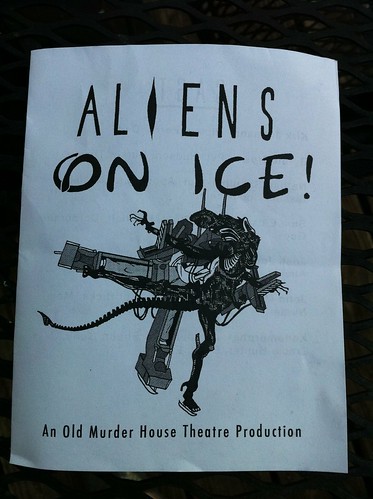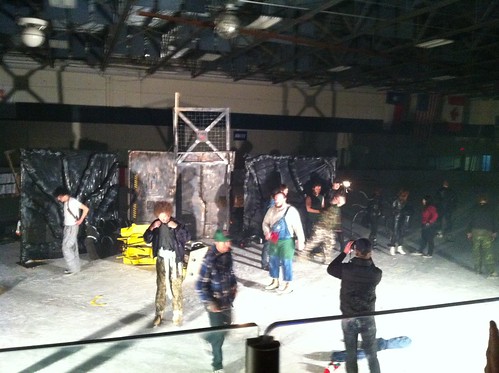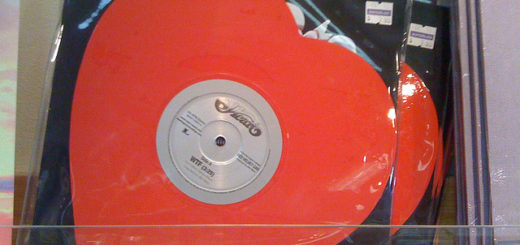Pop Culture Remixing: Why it Matters that We Keep Remaking Familiar Pop Culture Properties.
At 11 p.m. on the Saturday before Thanksgiving, my husband and I walked into the Chaparral Ice rink in North Austin. Despite the warm day, I was carrying my winter coat, hat and gloves. We were going to the theater!
Less a traditional theatrical experience and more of a chance to see a comedic trainwreck, we had tickets for Aliens on Ice by The Old Murder House Theatre.
Yes, we’d paid to see the movie “Aliens” recreated at an ice rink by a cast just slightly beyond being able to stand up on their ice skates.
That Saturday night was do-it-yourself (DIY) theater at its finest. One theatrical set was comprised of hand drawn illustrations on cardboard that were attached to a pink ironing board. You could clearly see the duct tape holding things together.
Costuming wasn’t much fancier. The mostly male cast changed characters by adding or removing wigs in full view of the audience. One alien picked up his headpiece as he skated by. It had fallen off during a dramatic fight scene. This show was a very long way from Broadway.
Despite the ludicrously low production values of “Aliens on Ice” the audience was mostly eating it up, laughing along at the comedy.
That night at the ice rink, we’d happened to sit next to our friends Charles and Charlene Smith, who’d left the kids home and who were out on their date night. Charlie Smith, 31– whom I know from my own lower-rent theatrical collective/charity project of Scare For a Cure—had actually worn out the VHS tape of “Aliens” when he was younger. Later, Smith owned up to having played “Aliens” on the playground, much the way some kids played “Cowboys and Indians.”
Before that ice show, I’d never seen the movie “Aliens.” Yet I laughed so hard during the production that I managed to send myself into coughing fits.
I wasn’t surprised to see the rest of the audience also enjoying itself. During the show they were immersed in pop culture, something that’s as comfortable as a pair of much-loved flannel pajamas for many Americans.
“Aliens on Ice” it isn’t alone in allowing people to immerse themselves in pop culture.
Over the last few years I’ve noticed an increasing number of creative projects based around the idea of “remixing” fictional properties created by a different author.
I’m defining “remixing” as someone taking a fictional universe created by one person, then creating another project based on that universe.
Thus “remixing” might include what happens when the works of Jane Austen are updated to become “Pride and Prejudice and Zombies” or when people revisit characters first found in L. Frank Baum‘s “Wizard of Oz” books resulting in the musical “Wicked.”
In addition to “Aliens on Ice” the weekend before Thanksgiving gave us local productions including: “Cover to Cover” about creating new stories featuring Nancy Drew and the Hardy Boys, and improvisational theater based on the British TV show “Doctor Who.”
I talked to several people involved in these creative projects. While everyone had a different backstory about coming to the material, the people behind these remixes often said that they were creating projects out of love for the original creative property. Yet, with so much remixing going on, I figured there had to be an underlying reason.
“It’s comfort and creativity in one package” Julie Gillis, 42, said during a phone interview about “Cover to Cover” the Nancy Drew based show where she was co-director.
It was the concept of comfort that caught me.
Our world is a scary place. Unemployment is high and our country has long been conducting multiple foreign wars. Many people are deeply worried about the future.
I think the same underlying economic uncertainty that’s generating Occupy protests across the country is, for other people, motivating them to seek solace in the intellectually familiar.
While Occupy protests took this uncertainly and directed it outwards, I suspect some people—without realizing it—are dealing with this political and economic anxiety by recreating and/or consuming comfortable pop culture properties.
I think this is an “Occupy Pop Culture” movement. It’s driven by the same uncertainty that has put comfort food like mac’n’cheese on the grown-up menu at many American restaurants.

























